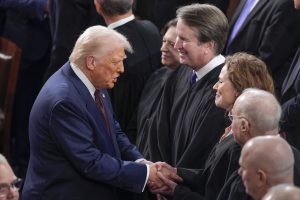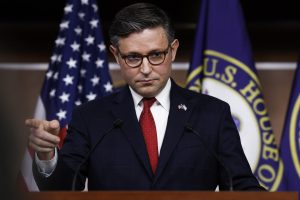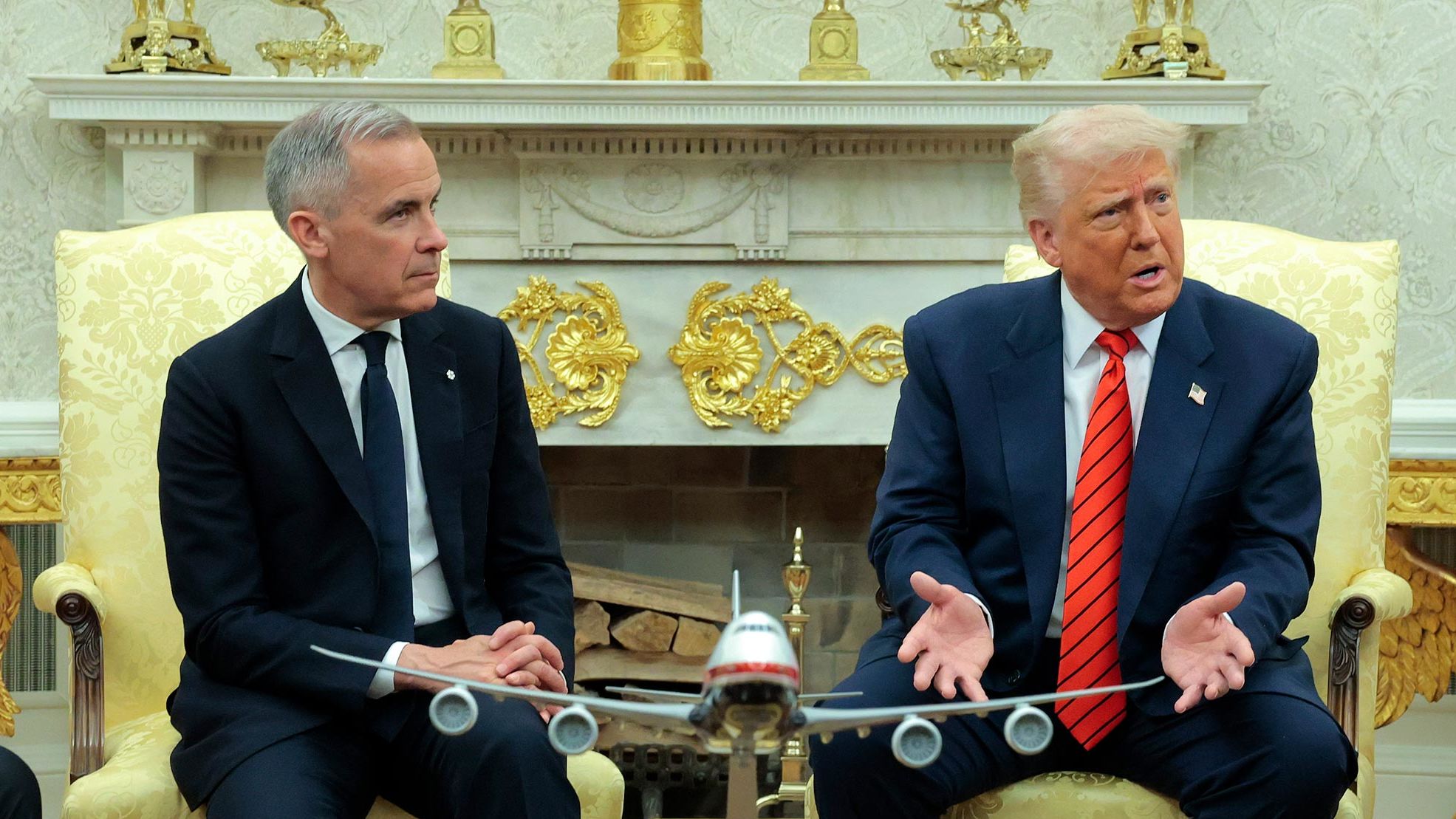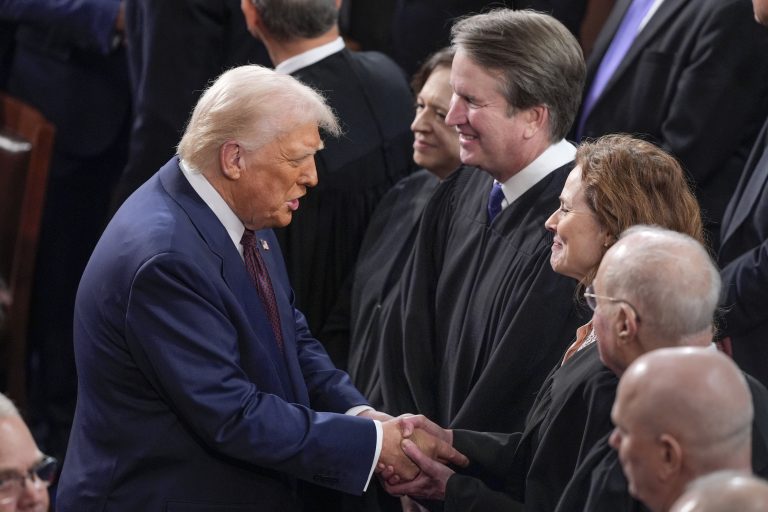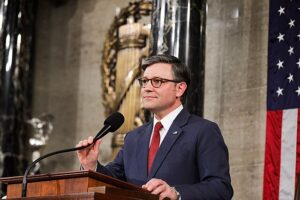A passing comment by President Donald Trump during a trade meeting with Canadian Prime Minister Mark Carney has reignited speculation about his long-standing idea of a potential “merger” between the United States and Canada. The remark, made amid renewed tariff negotiations in Washington, follows months of escalating trade tension and Trump’s previous suggestion that he could use “economic force” to achieve deeper integration between the two nations.
On Tuesday (October 7), President Trump, 79, welcomed Prime Minister Carney, 60, to the Oval Office for a bilateral meeting focused on trade disputes, tariff structures, and industrial cooperation. The encounter came just weeks after the United States raised tariffs on a range of Canadian imports to 35 percent — a move that prompted Ottawa to impose its own retaliatory levies on American goods.
The two leaders’ talks were part of a broader effort to ease the trade war that began in February, when Trump announced sweeping duties on Canadian products, citing “national security and border concerns.” The measures, which initially covered a wide range of goods, were later refined to exclude items already protected under the Canada–U.S.–Mexico Agreement (CUSMA). However, several sector-specific tariffs remain in place, including a 50 percent duty on metals and a 25 percent tariff on automobiles.
According to officials familiar with the meeting, Trump and Carney shared a private lunch where they discussed potential adjustments to the tariff framework. Photographs from the meeting showed the two leaders speaking in an apparently cordial but serious tone, highlighting the complexity of a trading relationship that has been both mutually beneficial and politically charged for decades.
Despite the tension, Trump struck an optimistic note when speaking to reporters afterward, emphasizing what he described as “mutual love” between the two North American allies. “The people of Canada will love us again once they see what we’re doing,” he said. “They’re going to be very happy. Mark’s a very competitive guy, and I think we’re going to come to something great.”
Trump acknowledged that negotiations with Canada had proven “more complicated than maybe any other agreement” the United States has worked on, attributing the difficulty to the two nations’ competition for similar industries. “The problem is that they want a car company, and I want a car company. They want steel, and we want steel,” he said. “In other countries, they’re very far away — there’s no overlap. With Canada, everything’s right there, side by side.”
While the White House has yet to release a detailed readout of the discussions, Trump hinted that the CUSMA agreement — signed in 2020 to replace NAFTA — might soon be subject to renegotiation. “A lot of people thought CUSMA was finished business,” he said. “But when you look at how things are going, maybe there’s room for improvement.”
Before the talks began, Carney referred to Trump as a “transformative president,” praising several of his second-term achievements and noting that the two countries share “a long and proud history of cooperation.” It was during this exchange, according to BNN Bloomberg, that Trump made his now-viral quip referencing a possible “merger” between the United States and Canada.
“And the merger of Canada and the United States,” Trump said with a grin, a remark that drew laughter from some in attendance but also immediate headlines around the world.
Though the comment appeared to be offhand, it revived months of speculation about Trump’s view of Canada’s strategic and economic importance. Earlier this year, he had been asked during a press conference whether he was considering the “annexation” of Canada by military means — a question he swiftly dismissed. “No,” he said. “Economic force.”
The remark, while seemingly rhetorical, signaled the former businessman’s willingness to leverage trade pressure as a geopolitical tool. In a separate speech in Palm Beach earlier this year, Trump mused about the concept of a unified North American entity, suggesting that removing “artificially drawn lines” could strengthen both nations’ security and prosperity. “It would really be something,” he said. “You get rid of the line, take a look at what that looks like — it would be much better national security. Don’t forget: we basically protect Canada.”
Former Canadian Prime Minister Justin Trudeau, who left office in 2024, responded firmly to Trump’s earlier statements, saying there wasn’t a “snowball’s chance in hell” that Canada would ever become part of the United States. “Workers and communities in both our countries benefit from being each other’s biggest trading and security partners,” Trudeau posted on X (formerly Twitter), rejecting any suggestion of annexation or unification.
Following Tuesday’s meeting, both Trump and Carney remained reserved about what was actually agreed upon. Trump described the talks as “productive,” while Carney called them “positive and effective.” However, neither leader confirmed whether a new trade deal had been finalized or whether the existing tariffs would be reduced in the coming months.
The potential renegotiation of CUSMA could have far-reaching implications. Analysts note that Canada is the United States’ second-largest trading partner, with bilateral trade exceeding $900 billion annually. The new tariffs, particularly those affecting metals and automobiles, have already caused disruption across supply chains, with Canadian manufacturers warning of rising costs and potential layoffs.
Trump, however, has framed the tariffs as a way to strengthen American industry. “We’re just making sure it’s fair,” he told reporters. “We love Canada, but we can’t let our workers be taken advantage of.”
Carney, a former central banker and financial executive, has taken a more diplomatic tone, emphasizing the need for stability. “Our economies are deeply intertwined,” he said. “It’s in both of our interests to ensure trade remains open, fair, and predictable.”
Still, Trump’s offhand “merger” comment overshadowed much of the policy discussion, becoming the headline moment of the day. It echoed previous instances where Trump used humor or provocation to float ideas that blur the line between jest and strategy. During his presidency, similar remarks about acquiring Greenland or reasserting control over the Panama Canal were initially dismissed as jokes — only for later reporting to show that preliminary discussions had, in fact, taken place within his administration.
The idea of a U.S.–Canada merger is not new in North American political discourse, though it has long been regarded as unrealistic. Proponents argue that the two countries’ shared language, culture, and defense commitments under NORAD make integration conceivable. Critics, however, warn that such a move would undermine Canadian sovereignty and destabilize global trade networks.
Following the meeting, Trump declined to elaborate further on his comment. “It was just a thought,” he said when pressed by a reporter. “We have a great relationship with Canada. We’re going to keep it that way.”
Carney, meanwhile, dismissed the remark with a smile. “We have a lot to talk about on trade,” he said. “That’s our focus.”
As of now, no formal announcements have been made regarding the outcome of the tariff negotiations. White House officials have indicated that discussions will continue “in the coming weeks,” with both sides expected to finalize details before the end of the year.
Whether Trump’s “merger” remark was merely a throwaway line or an early glimpse into a more ambitious geopolitical vision remains to be seen. What is clear, however, is that the U.S.–Canada relationship — one of the closest and most complex in the world — continues to evolve under the weight of economic rivalry, shared security concerns, and the unpredictable diplomacy of the Trump era.

Emily Johnson is a critically acclaimed essayist and novelist known for her thought-provoking works centered on feminism, women’s rights, and modern relationships. Born and raised in Portland, Oregon, Emily grew up with a deep love of books, often spending her afternoons at her local library. She went on to study literature and gender studies at UCLA, where she became deeply involved in activism and began publishing essays in campus journals. Her debut essay collection, Voices Unbound, struck a chord with readers nationwide for its fearless exploration of gender dynamics, identity, and the challenges faced by women in contemporary society. Emily later transitioned into fiction, writing novels that balance compelling storytelling with social commentary. Her protagonists are often strong, multidimensional women navigating love, ambition, and the struggles of everyday life, making her a favorite among readers who crave authentic, relatable narratives. Critics praise her ability to merge personal intimacy with universal themes. Off the page, Emily is an advocate for women in publishing, leading workshops that encourage young female writers to embrace their voices. She lives in Seattle with her partner and two rescue cats, where she continues to write, teach, and inspire a new generation of storytellers.

